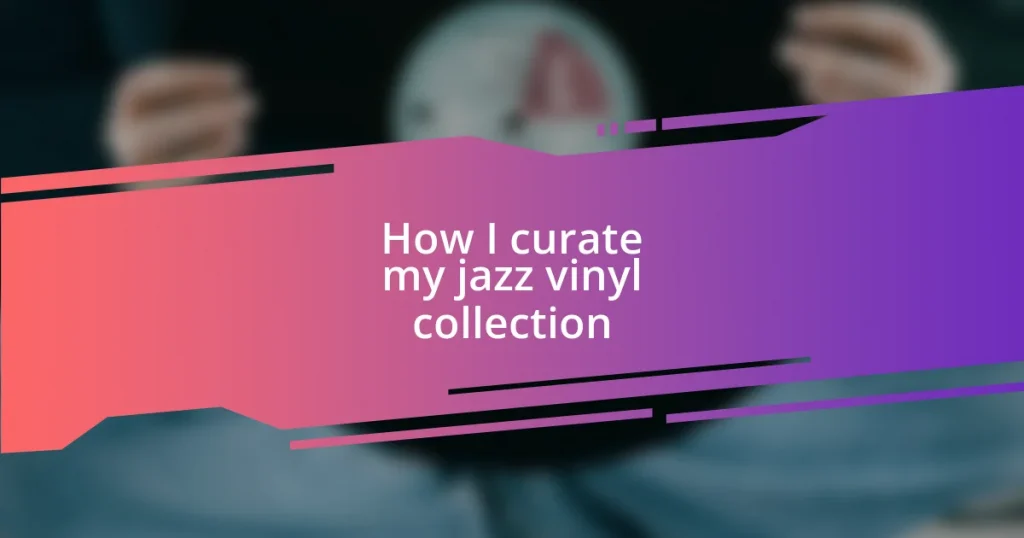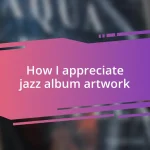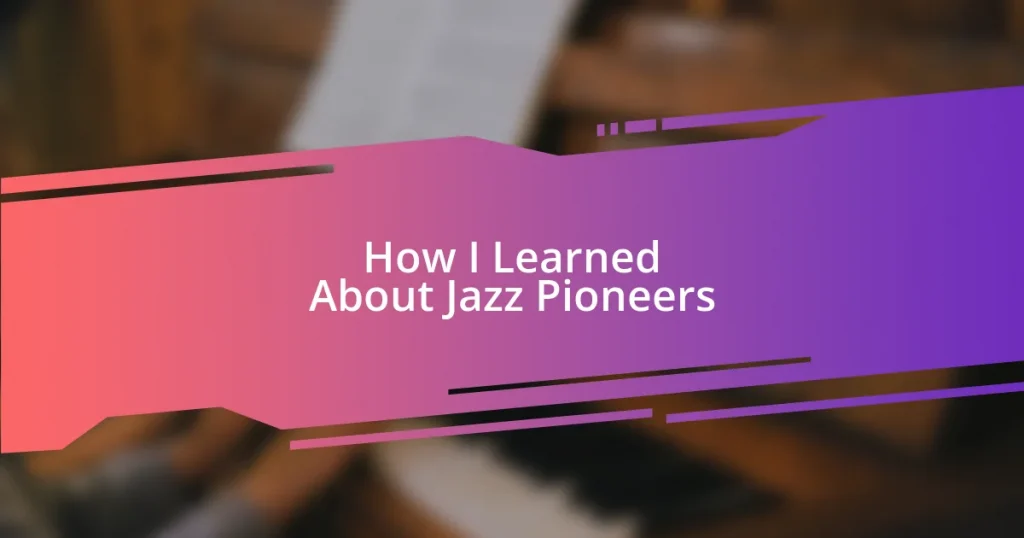Key takeaways:
- Starting a jazz vinyl collection connects collectors to music history and personal memories, providing a rich exploration of sound and culture.
- Understanding jazz genres such as bebop, cool jazz, and jazz fusion enhances the collecting experience by revealing the emotional and historical contexts of the music.
- Proper care and strategic expansion of the collection, including assessing vinyl quality and building a personalized catalog, are essential for maintaining and enriching a jazz vinyl collection.
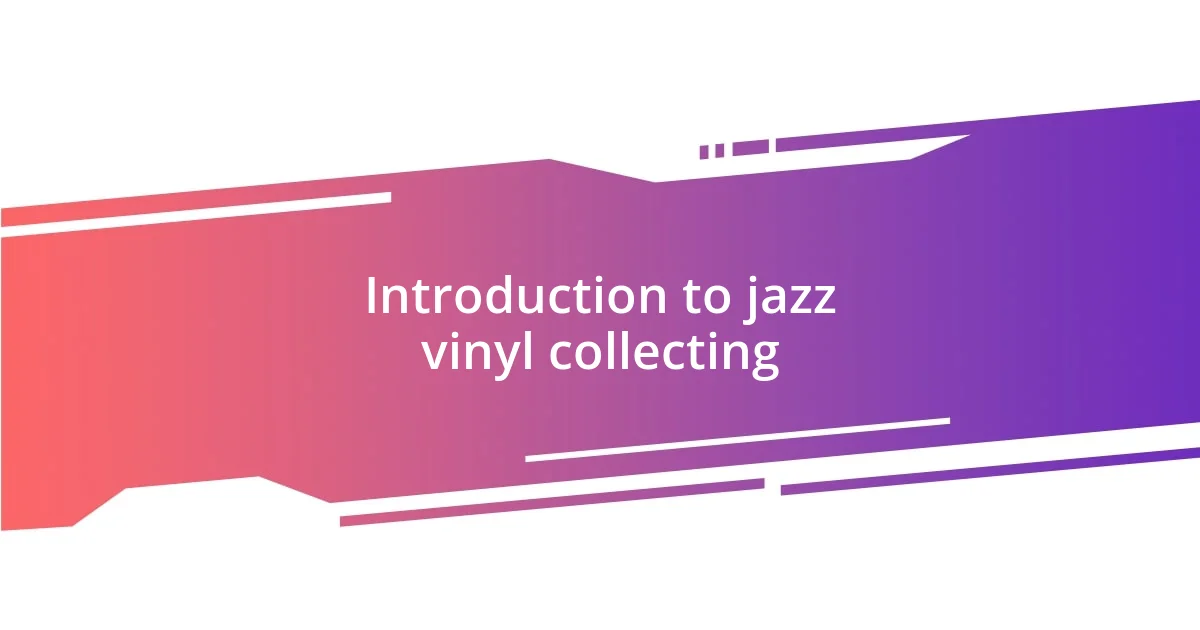
Introduction to jazz vinyl collecting
There’s something magical about holding a piece of music history in your hands, especially when it comes to jazz vinyl. I still remember the first time I stumbled upon a pristine Ella Fitzgerald record at a flea market; the moment felt electric, as if I’d uncovered a treasure. Each vinyl tells a story, connecting me with the artists and the time they lived in.
As I sift through crates, I often wonder what drew the previous owners to these records. Was it the soulful trumpet of Miles Davis, or the smooth saxophone of John Coltrane that captivated them? While collecting jazz vinyl, you not only acquire music but also fragments of memories and emotions that have transcended generations.
In my experience, starting a jazz vinyl collection can evoke a sense of nostalgia, perhaps even a longing for a different era. It’s an exploration of sound that goes beyond mere listening; it’s about immersing yourself in a culture that celebrates improvisation and creativity. What sounds do you want to weave into the fabric of your own life? That’s the beauty of curating your collection.
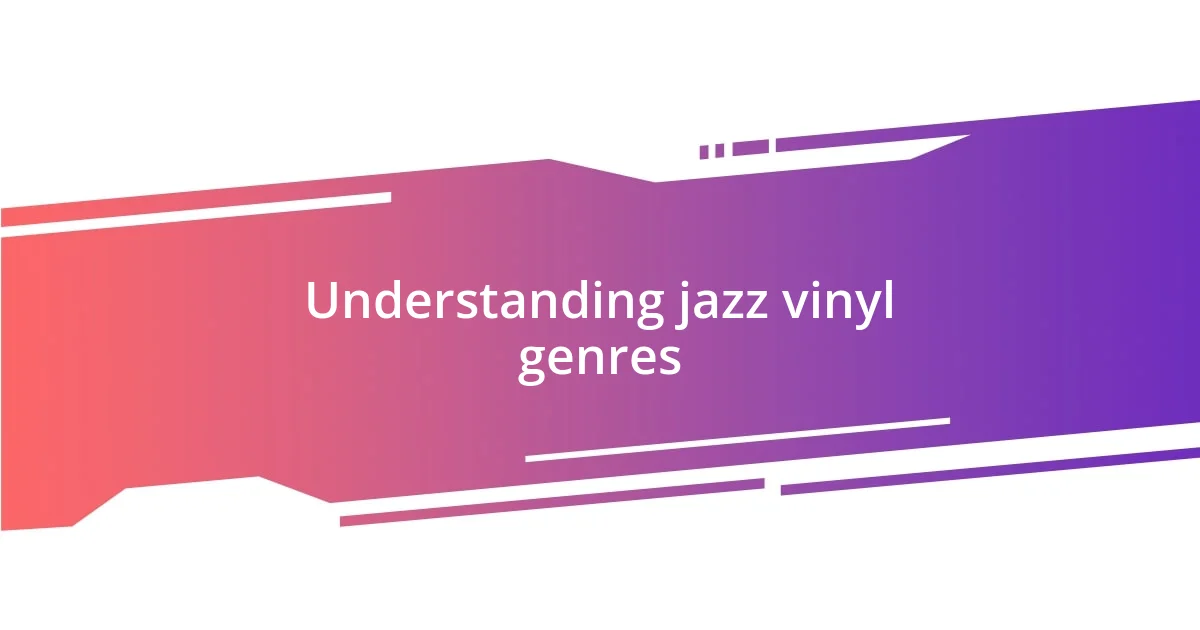
Understanding jazz vinyl genres
Understanding jazz vinyl genres opens a window to the rich tapestry of music styles that define this genre. As I navigated my own collection journey, I found that each genre has its nuances, reflecting everything from the historical context to the emotional depth of the music. For instance, I recall a cozy afternoon spent rummaging through records, where I discovered the haunting beauty of modal jazz, thanks to a rare Bill Evans album. The way the notes wove in and out felt like a conversation between the musicians—one that I wanted to be part of.
Here are some key jazz genres to consider for your vinyl collection:
- Bebop: Fast-paced and complex, focusing on improvisation. Artists like Charlie Parker and Dizzy Gillespie are staples.
- Cool Jazz: Smooth and laid-back, emphasizing tone and arrangement. Think of the dreamy sounds of Miles Davis and Chet Baker.
- Hard Bop: A fusion of bebop with blues and gospel. It often includes notable figures like Art Blakey and Horace Silver.
- Free Jazz: Experimental and avant-garde, prioritizing improvisation over traditional structure, led by visionaries like Ornette Coleman.
- Jazz Fusion: A blend of jazz, rock, and funk, combining electric instruments. Think Weather Report and Chick Corea for a vibrant listening experience.
Each genre tells a story, and through my collection, I’ve found that these stories resonate with my own experiences and emotions.
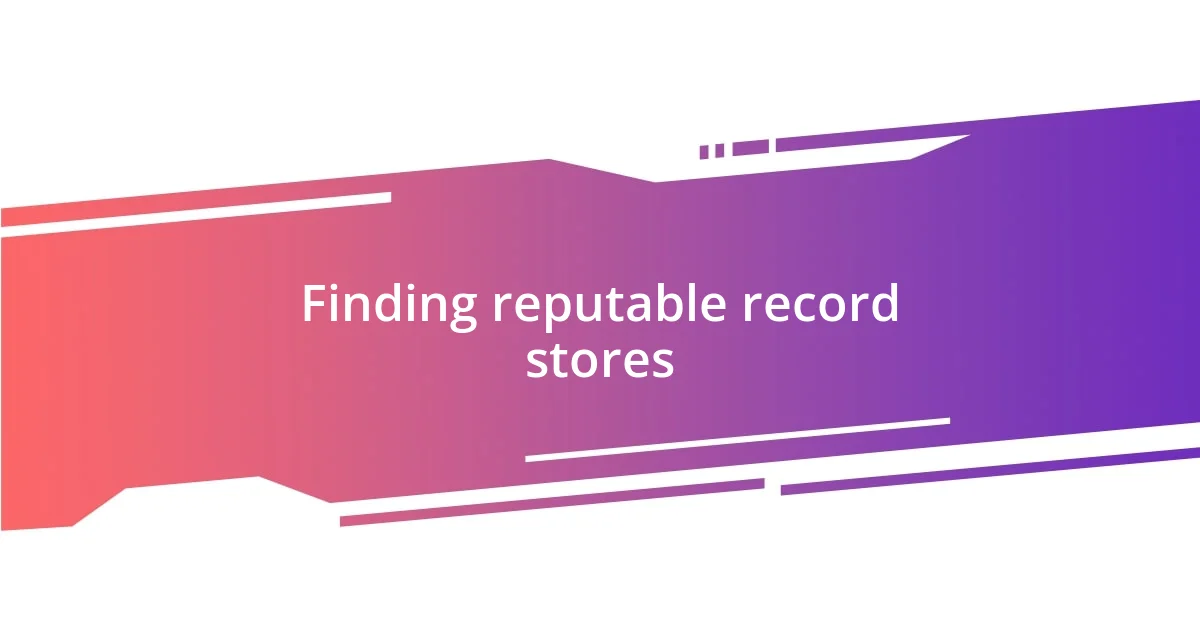
Finding reputable record stores
Finding reputable record stores is essential for any serious jazz vinyl collector. I’ve spent hours wandering through various shops, but I’ve learned that not all stores are created equal. A good record store should offer a welcoming atmosphere and knowledgeable staff who share your passion for music. I remember my first visit to a local store that specialized in jazz; the owner not only guided me to hidden gems but also shared fascinating stories about the artists and albums.
When seeking out record stores, I often turn to online reviews and recommendations from fellow collectors. Checking platforms like Yelp or social media groups can lead you to unexpected treasures. Recently, I discovered a small shop tucked away in an alley, with walls lined with classic and rare records, all thanks to a recommendation from a friend. The warmth of that community makes the process of finding new music feel truly special.
Additionally, attending vinyl fairs and record conventions can be a fantastic way to meet reputable dealers. It was at a local vinyl fair that I found a first pressing of a Coltrane album that still gives me goosebumps every time I play it. Engaging with vendors and discussing your interests can foster a connection that leads to discovering unique pieces for your collection. Ultimately, building relationships with both stores and fellow collectors is crucial in creating a fulfilling vinyl journey.
| Store Type | Pros |
|---|---|
| Independent Record Stores | Unique selections, knowledgeable staff, community atmosphere |
| Chain Music Retailers | Wider variety, online availability, frequent promotions |
| Flea Markets and Fairs | Rare finds, lower prices, local vendors |
| Online Marketplaces | Convenience, broad selection, collector networks |
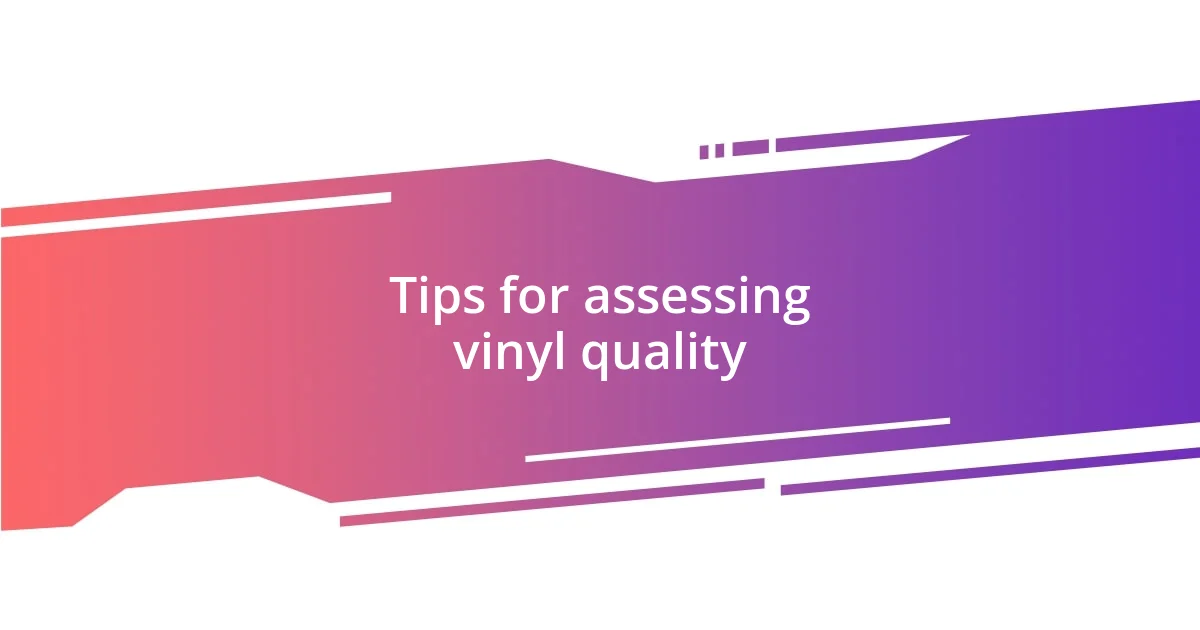
Tips for assessing vinyl quality
When assessing vinyl quality, the first thing I always check is the surface condition. A quick visual inspection can reveal a lot—look for scratches, dust, or any discoloration that might affect playback. I once picked up a gorgeous Jazz at the Pawnshop album, only to discover a deep scratch that rendered it unplayable. It was such a disappointment, but it taught me the hard way to never underestimate the importance of a careful examination.
Next, I put the vinyl to the test—literally. If I’m at a record store, I ask if I can play it. Listening for pops, clicks, and skipping can truly indicate how well the record has been maintained. There was a time when I was hesitating over a tempting live Miles Davis album. As I listened, the rich, warm sound enveloped me, and I could tell the previous owner had taken excellent care of it. That was a moment I won’t forget.
Finally, don’t overlook the importance of the inner sleeve and outer packaging. A scratched or damaged cover can diminish the overall appeal, and I remember feeling a mix of excitement and regret when I found a Coltrane record with a frayed sleeve. Despite the pristine vinyl inside, it reminded me that the entire presentation matters, especially when it comes to building a collection you’re proud of. Have you ever experienced the joy of unearthing a vinyl treasure that ticked all the boxes? It’s these details that really elevate the experience.
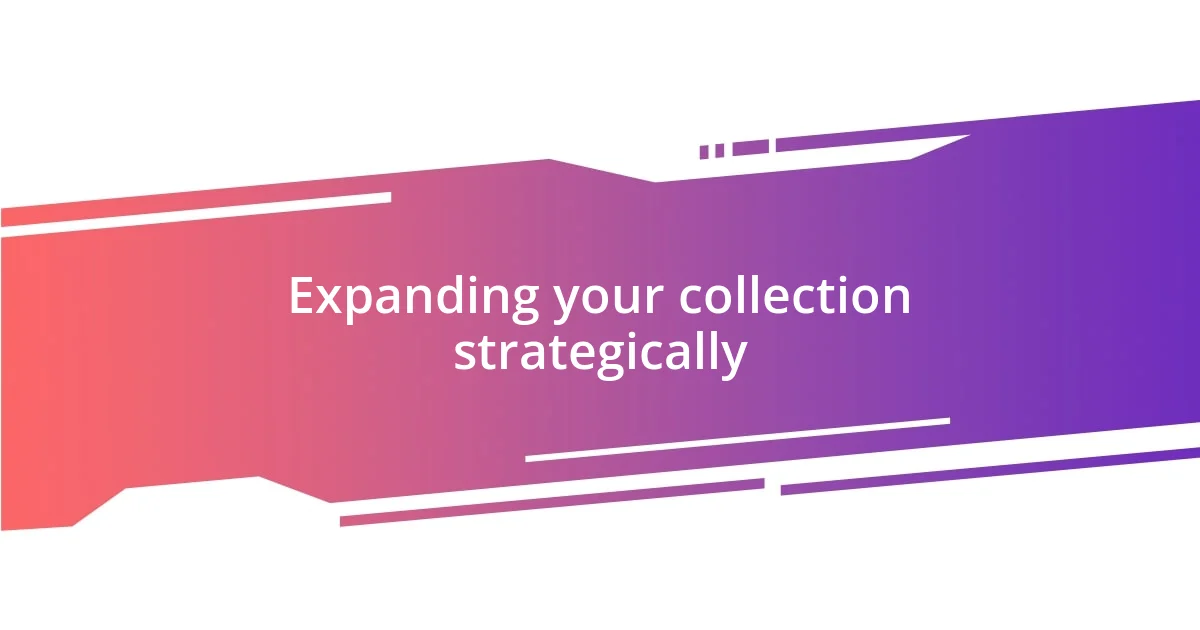
Expanding your collection strategically
When expanding my jazz vinyl collection, I find it helpful to focus on specific themes or artists to guide my purchases. For instance, I once decided to explore the legendary Blue Note label, and as I dug deeper, I uncovered how each artist contributed to a unique sound. This targeted approach not only makes the hunt more enjoyable but also helps to create a cohesive collection that tells a story. Have you ever curated a collection around a singular theme? It can really deepen your appreciation for the genre.
Another strategy I’ve adopted is keeping an eye on upcoming releases and limited editions. I remember stumbling upon an announcement for a remastered version of a classic Bill Evans album. I marked my calendar, and that anticipation turned into sheer joy when I finally secured a copy. Timing is crucial; sometimes, the most exciting finds are those that aren’t even in stores yet! Are you proactive about seeking new releases, or do you prefer the thrill of the hunt in back catalogs?
Lastly, I’ve learned to be patient and hold out for high-quality finds rather than rushing to fill my shelves. Once, I almost settled for a lesser-known album simply to add something new to my collection. But instead, I waited, and later discovered a pristine pressing of “A Love Supreme” at a fair. That moment reinforced for me the beauty of vinyl collecting—it’s not just about quantity, but quality. How do you prioritize your purchases? Do you let the excitement of digging dictate your decisions, or do you practice restraint in your collecting journey?
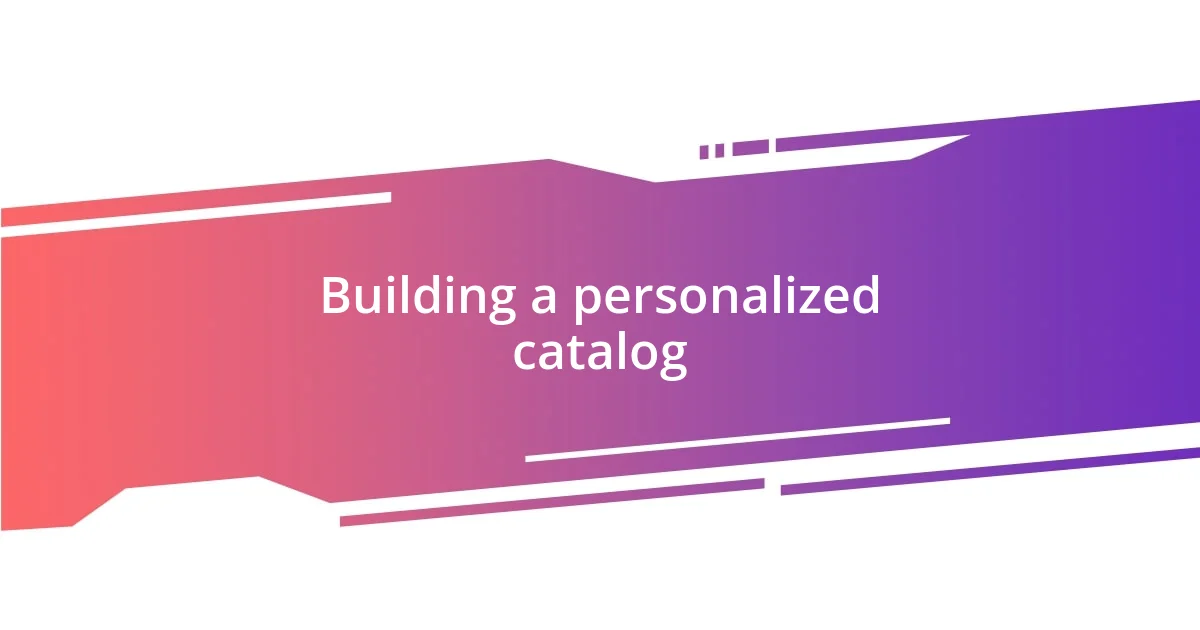
Building a personalized catalog
Building a personalized catalog has been one of the most rewarding aspects of my vinyl collecting journey. I often start by creating a spreadsheet where I log essential details—my favorites, the artists, and even when and where I bought each album. It may seem a bit tedious at first, but I can’t tell you how satisfying it is to look back at my entire collection and see not just a list, but a reflection of my musical evolution. Have you ever felt a similar sense of accomplishment when organizing your hobbies?
As I categorize my collection, I always include notes on the unique features of each vinyl. Whether it’s a special pressing or a particularly memorable listening experience, these little notes bring my catalog to life. For instance, I recently wrote about a Rachmaninoff-inspired jazz vinyl that I bought on a whim. Every time I see that entry, it reminds me of that serendipitous day spent sifting through stacks, and how the unexpected can lead to incredible discoveries. Don’t you think that personal stories behind each record add an unexpected layer to the collection?
Lastly, I love to incorporate genre overlaps and personal favorites in my catalog. Jazz seamlessly blends with blues and soul, and capturing these intersections can create a rich tapestry in my collection. I remember feeling thrilled when I discovered an album that mixed elements of jazz with Latin influences; it opened new avenues of exploration for me. It’s incredible how interconnecting genres can spark curiosity and inspire further acquisitions. How do you approach finding those unexpected gems in your own music catalog? It’s those surprises that keep the passion alive.
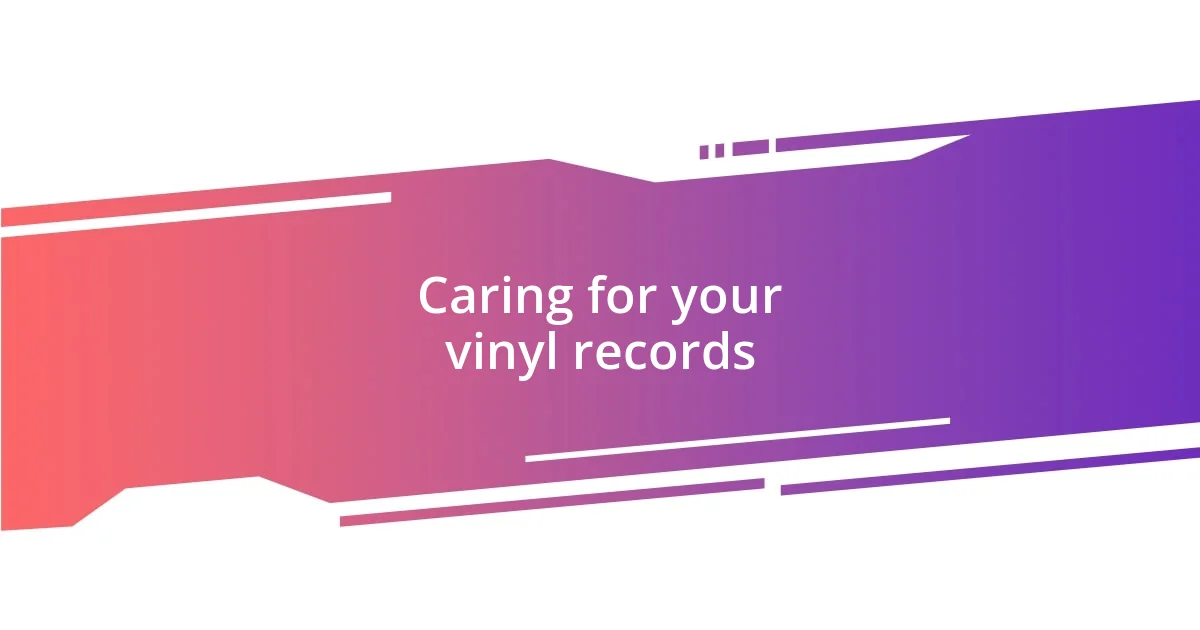
Caring for your vinyl records
When it comes to caring for my vinyl records, I’ve learned that proper storage is essential. I always store my albums vertically, just like books on a shelf. It prevents warping and keeps them in excellent shape. Have you ever noticed how a simple adjustment can make a big difference? It’s amazing what a little bit of awareness can do for your collection.
I’ve also discovered the importance of cleaning my records regularly. Investing in a quality record cleaning brush has made my listening experience so much better. I’ve found that a quick clean before each play removes dust and debris, enhancing sound quality significantly. Have you experienced that satisfying moment when you drop the needle and hear crisp music without any unwanted crackles? It’s truly rewarding!
Finally, I can’t stress enough the role of a good turntable mat. Once, I switched to a higher-quality mat, and the improvement in audio clarity was astonishing. It felt like I had opened a new window to my favorite albums. It’s the little upgrades that often lead to big revelations, don’t you think? Taking these small but impactful steps truly elevates how I enjoy my vinyl collection.










